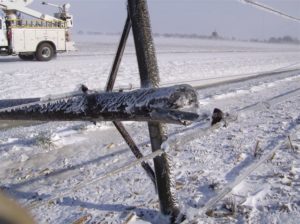Look Out For Galloping Lines
Hi gh winds and ice can affect power lines in a way that makes them gallop. Strong winter winds can cause ice to build up on one side of a power line. When this disproportionate buildup occurs, it changes the flow of air around the line, which can then cause it to start bouncing. This galloping can potentially damage the lines, cause power outages, and even make the lines to fall to the ground.
gh winds and ice can affect power lines in a way that makes them gallop. Strong winter winds can cause ice to build up on one side of a power line. When this disproportionate buildup occurs, it changes the flow of air around the line, which can then cause it to start bouncing. This galloping can potentially damage the lines, cause power outages, and even make the lines to fall to the ground.
Once galloping starts, there is not much a power company can do to alleviate it until winds die down. This is why many power lines have objects, like twisted wire or round or angular pieces of metal attached to the line. These devices are placed on power lines to help reduce the galloping of lines and prevent potential danger.
Stay away from galloping lines. If you see galloping or downed lines, contact your utility as soon as possible.
It is important to keep your distance from downed power lines, as it is impossible to visually assess if the line is energized. Exercise caution while driving during adverse weather conditions, and prepare your home for a power outage.
Be sure to have a storm preparedness kit ready before a storm strikes to help get you and your family through a power outage. This kit includes: bottled water, non-perishable food, blankets, warm clothing, first aid kit/medicine, flashlight, radio, extra batteries, and toiletries.
Safe Electricity offers additional tips on how to stay warm during a winter power outage:
- Stay inside, and dress warm.
- Close off unneeded rooms and place draft blocks at the bottom of doors to minimize cold air entering the house.
- Cover windows at night.
- Be aware of the temperature in your home. Infants and elderly people are more susceptible to the cold. You may want to stay with friends or relatives or go to a shelter if you cannot keep your home warm.
- When the power is restored, there will be a power surge. To protect your circuits and appliances, switch off lights and unplug appliances. Leave one light switched on as a quick reminder that the power is restored.
For more information on electrical safety, visit SafeElectricity.org.
